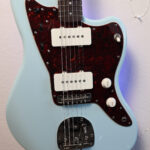Warmoth is a highly respected name in the guitar world, renowned for crafting high-quality custom guitar parts, particularly Guitar Necks Warmoth. For musicians embarking on custom builds or seeking replacement necks, Warmoth offers a wide array of options, from different woods and profiles to fret types and finishes. However, a common point of concern, especially for first-time Warmoth customers, revolves around the initial straightness of their necks right out of the box.
Recently, a guitar builder encountered a situation where a brand new Warmoth maple neck exhibited a slight concave bow upon arrival. This led to questions about whether this is normal and if it indicates a potential problem. It’s important to understand that a slight bow in an unstrung guitar neck is not necessarily a defect; in fact, it’s often intentional and crucial for optimal playability once the guitar is strung to pitch.
This intentional bow is known as “neck relief.” Warmoth, like many reputable neck manufacturers, mills their necks with a slight under bow. This is because the tension of guitar strings pulls the neck forward, naturally straightening it to some degree. Without this initial relief, a neck could become back-bowed (convex) under string tension, leading to buzzing strings and high action.
The luthier who inspected the Warmoth neck in question noted a 1/32” concave bow and expressed concern, suggesting a perfectly straight neck is ideal and fearing potential issues during assembly and long-term stability. While a luthier’s expertise is valuable, it’s crucial to consider the manufacturer’s specifications and the intended function of neck relief.
An example of a Warmoth guitar neck showcasing the craftsmanship and detail that goes into each custom part.
Warmoth explicitly states that their “necks are intentionally milled with an under bow (string relief) which is apparent when the truss rod is slack.” This is standard practice in guitar manufacturing. The truss rod, an adjustable steel rod within the neck, is designed to fine-tune the neck relief once strings are installed and brought to tension.
A 1/32” concave bow on a Warmoth neck, as described, is well within the expected range for an unstrung neck designed for typical string gauges and tunings. Attempting to force a brand new Warmoth neck to be perfectly straight by excessively tightening the truss rod before stringing it up is not recommended and could potentially damage the neck or truss rod mechanism.
The key is to assess the neck relief once the guitar is fully assembled and strung to pitch. At that point, minor adjustments to the truss rod can be made to achieve the optimal amount of relief for comfortable playing action and to eliminate string buzz.
Key Takeaways Regarding Warmoth Guitar Necks and Neck Relief:
- Intentional Relief: Warmoth necks are designed with a slight concave bow (under bow) to accommodate string tension.
- Normal Bow: A 1/32” concave bow in an unstrung Warmoth neck is generally considered normal and not a defect.
- Truss Rod Function: The truss rod is intended for fine-tuning neck relief after stringing, not for forcing an unstrung neck perfectly straight.
- Assembly is Crucial: The true straightness and playability of the neck should be evaluated after the guitar is fully assembled and strung.
- Warmoth’s Reputation: Warmoth has a long-standing reputation for quality and consistency in their neck manufacturing.
Before considering returning a Warmoth neck due to a slight concave bow, it is highly recommended to proceed with the guitar assembly. Once strung, the neck’s relief can be properly assessed and adjusted. If concerns persist after assembly and proper setup, then contacting Warmoth for warranty inspection would be the appropriate next step. However, in most cases, the initial concave bow is simply the intended starting point for a properly functioning and playable guitar necks warmoth.

